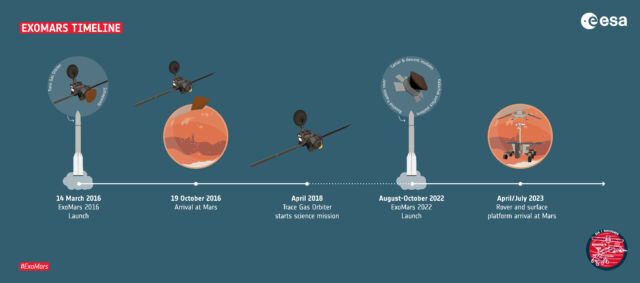
On Thursday, the European Space Agency and its Russian partners announced that they would be delaying their planned rover/lander mission to Mars. As we reported earlier this year, the project was facing a number of technical hurdles, and time was running short to sort them out before a convenient launch window for Mars closed. Now, travel restrictions put in place to limit the spread of the coronavirus have ensured that they won't be handled in time.
Life on Mars?
The project, termed ExoMars, is an ambitious one, intended to help determine if life might ever have existed on the red planet. It will include a Russian-built surface platform that includes weather instruments and the ability to monitor the exchange of volatile chemicals between the Martian atmosphere and its surface. But the star of the show would be the ESA's first rover on Mars, the Rosalind Franklin (named after a scientist who helped determine the structure of DNA).
The rover's key feature is the ability to drill down two meters below the Martian surface, a depth at which liquid water is more likely to be found and which would be somewhat shielded from the harsh radiation that bathes the Martian surface.
But getting all that to the surface requires a complicated landing system, and the ExoMars mission would use two sets of parachutes. Unfortunately, technical problems with this system had been apparent through multiple failed tests, and other issues had been identified with the hardware involved.
While these sorts of issues aren't uncommon (see, for example, the James Webb telescope), the journey to Mars adds an element of time pressure. There are times when the orbits of Earth and Mars place the planets in a configuration that greatly shortens the travel time involved. If the problems weren't sorted out quickly enough, the planned launch window would be unavailable, and the mission would have to be delayed until 2022.
To sort out the possibilities, ESA and Roscosmos officials scheduled a meeting for today to determine the final timeline.
Down to Earth issues
The agencies revealed that ground-based parachute testing had been successful, and a high-altitude drop test was set to happen later this month. All the scientific instruments had been integrated into the lander and rover, and testing on the descent module was also proceeding.
Despite this progress, Roscosmos Director General Dmitry Rogozin said that something new and unexpected had thrown the entire schedule off: the coronavirus. The mission would have to be delayed due to "circumstances related to exacerbation of the epidemiological situation in Europe, which left our experts practically no possibility to proceed with travels to partner industries."

His partner, ESA Director General Jan Wörner, sounded almost relieved by the additional time for testing the delay would allow. "We want to make ourselves 100 percent sure of a successful mission," he said via a statement. "We cannot allow ourselves any margin of error. More verification activities will ensure a safe trip and the best scientific results on Mars.”
The revised schedule sees a launch between August and October of 2022, with the landing to come the year following.
Bagikan Berita Ini














0 Response to "Coronavirus restrictions the final straw for ESA’s Mars Mission - Ars Technica"
Post a Comment